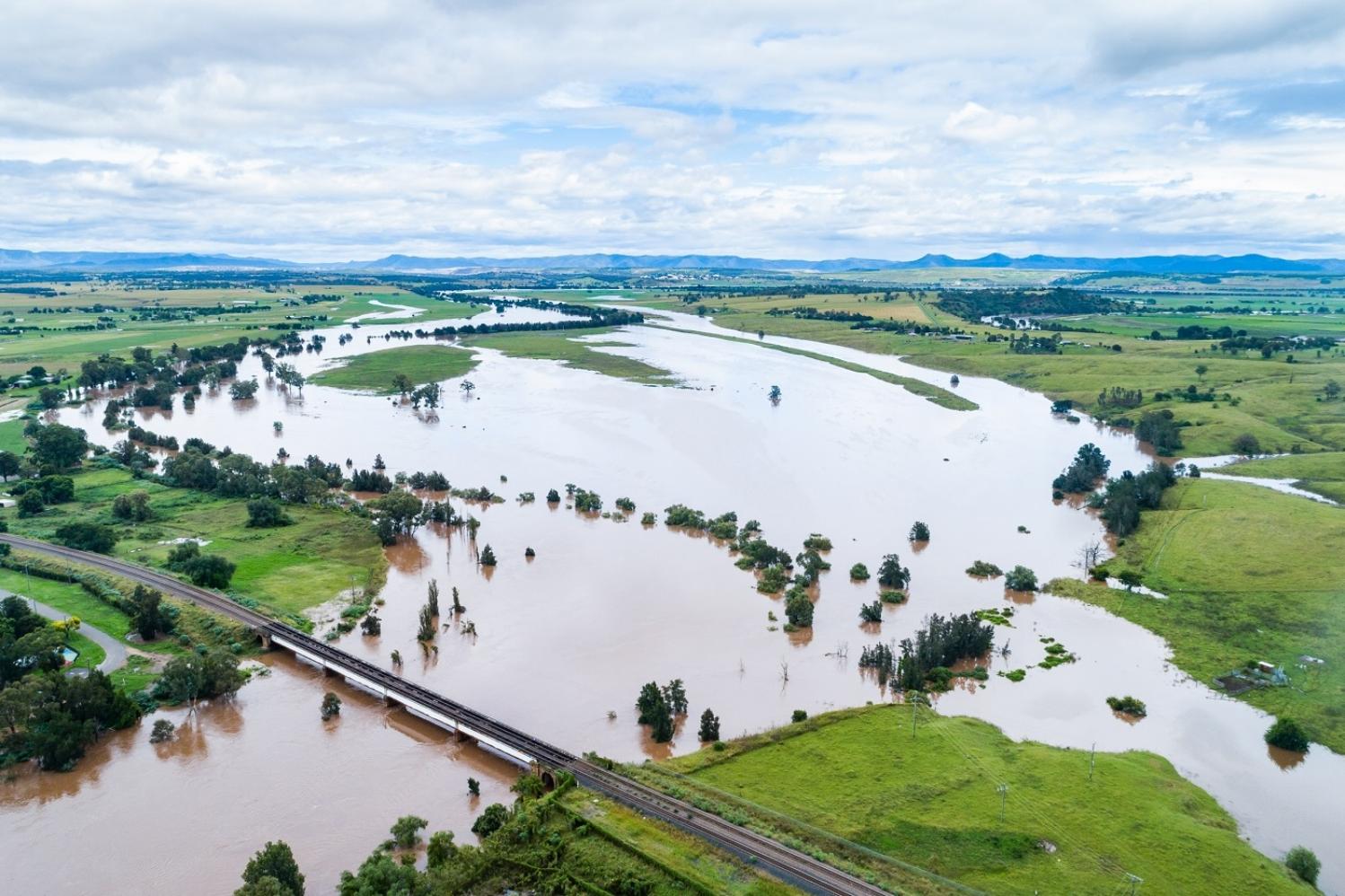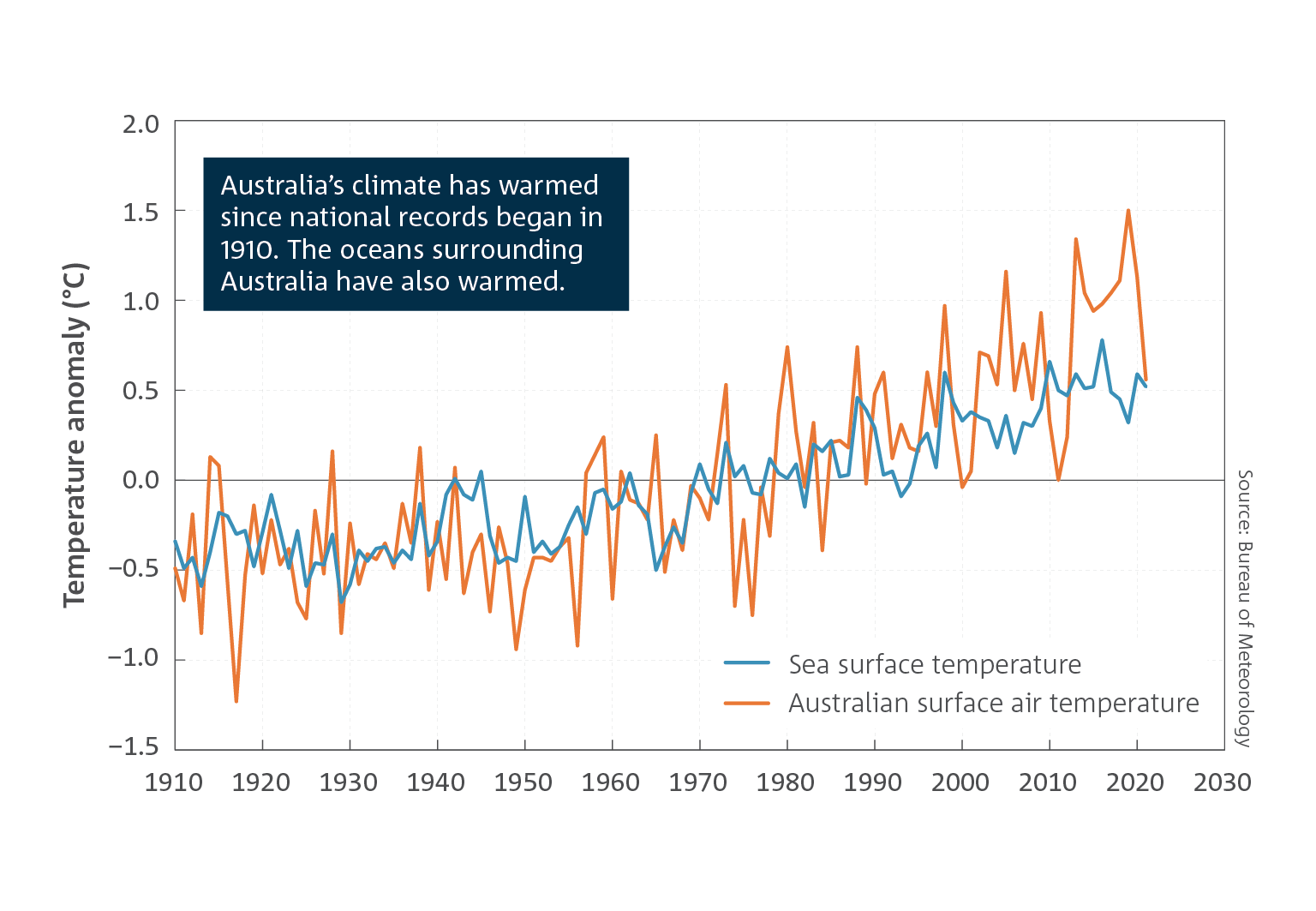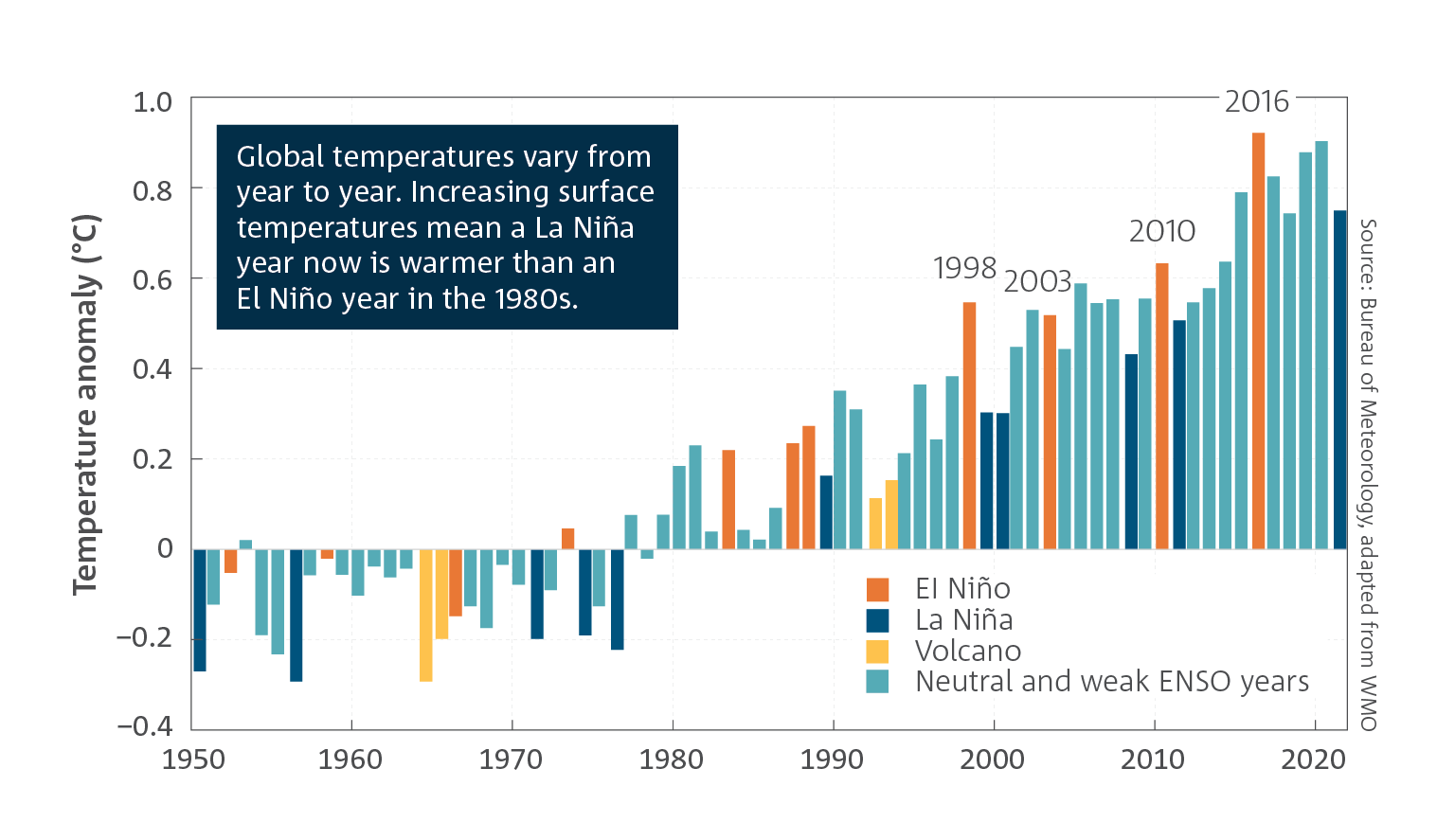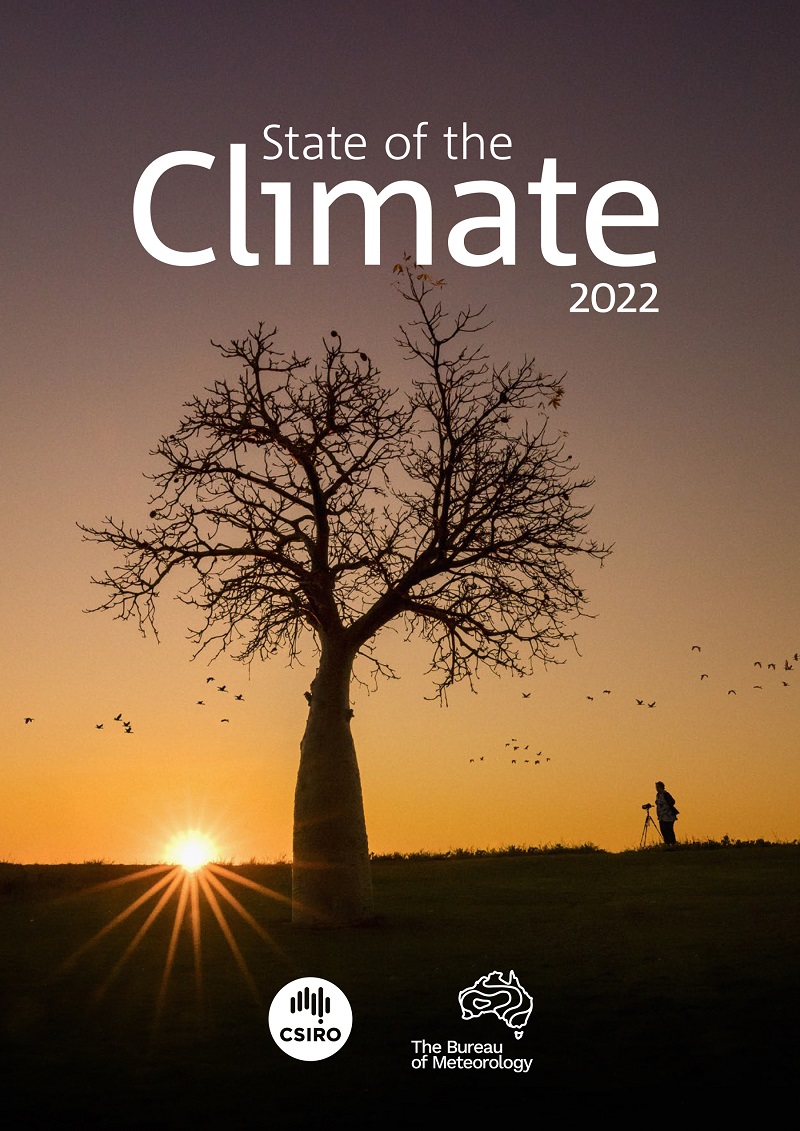November 27 - December 3, 2022: Issue 564
State Of The Climate 2022 – Australia Continues To Warm; Heavy Rainfall Becomes More Intense, Bushfire Season More Intense, Longer

The State of the Climate 2022 report, released Wednesday November 23rd by CSIRO and the Bureau of Meteorology, has found changes to weather and climate extremes are happening at an increased pace across Australia.
The report, released every two years, shows an increase in extreme heat events, intense heavy rainfall, longer fire seasons and sea level rise. The report draws on the latest climate monitoring, science and projection information to detail Australia’s changing climate now and into the future.
The Director of CSIRO’s Climate Science Centre, Dr Jaci Brown, said concentrations of greenhouse gases, such as carbon dioxide, are at the highest levels seen on Earth in at least two million years.
“The concentrations of greenhouse gases in the atmosphere are continuing to rise, and this is causing Australia’s climate to warm,” Dr Brown said.
Dr Brown said the report documents the continuing acidification of the oceans around Australia, which have also warmed by more than one degree since 1900.
“The warming of our oceans is contributing to longer and more frequent marine heatwaves, and this trend is expected to continue into the future,” Dr Brown said.
“We’re seeing mass coral bleaching events more often, and this year, for the first time, we’ve seen a mass coral bleaching on the Great Barrier Reef during a La Niña year.
“The rate of sea level rise varies around Australia’s coastlines, but the north and south-east have experienced the most significant increases.”
The Bureau of Meteorology’s Manager of Climate Environmental Prediction Services, Dr Karl Braganza, said the report projected increases in air temperatures, more heat extremes and fewer cold extremes in coming decades.
“Australia's climate has warmed on average by 1.47 degrees since 1910,” Dr Braganza said.
“We’ve seen contrasting rainfall trends across the north and the south of the country.
“There’s been an overall decline in rainfall between April and October across southern Australia in recent decades, but in northern Australia, rainfall has increased across the region since the 1970s.”
During La Niña events in 2021-22, eastern Australia experienced one its most significant flood periods ever observed.
The report shows heavy rainfall events are becoming more intense and the number of short-duration heavy rainfall events is expected to increase in the future.
Dr Braganza said the length of fire seasons has increased across the country in recent decades.
“We’re expecting to see longer fire seasons in the future for the south and east, and an increase in the number of dangerous fire weather days,” he said.
State of the Climate 2022 is the seventh report in a series published biennially by the Bureau of Meteorology and CSIRO, which together play an integral role in monitoring, measuring and reporting on weather and climate.
The State of the Climate 2022 report can be found on the CSIRO and Bureau of Meteorology websites.
Dr Michael Robertson, Director of CSIRO Agriculture and Food
“The threats caused by climate change, including extreme rainfall, droughts, heatwaves and bushfires, are already having widespread impacts on Australia’s agricultural industry, affecting food production and supply chains.
“Historically the sector has shown its ability to adapt to changes in climate, but we have an important role to play at CSIRO to help our farmers to build on that, navigating the growing climate risks to ensure long-term viability of rural enterprises and communities.
“We’re doing that through initiatives such as our Drought Resilience Mission and looking at sustainable integrated solutions for agriculture and land use, a great example of which is the Climate Services for Agriculture project, providing historical weather and climate projections on a 5 km grid, to allow farmers to see how climate is changing in ways relevant to what they produce.”
The project, a collaboration between CSIRO and the Bureau of Meteorology funded by the Australian Government’s Future Drought Fund, will help inform farmers where adaptations will be needed.
Dr Marita Niemelae – Director, CSIRO Energy
“Our energy sector is evolving to enable Australia’s transition to a net zero emissions energy future.
CSIRO’s research is taking an innovative approach to the whole of energy transition to provide pathways towards net zero. We are conducting analysis and modelling to support decarbonisation by identifying and enabling new opportunities for the responsible development of Australia’s vast energy resources.
CSIRO’s low emission technologies coupled with storage and resilient infrastructure can help deliver energy that meets our sustainability goals, while at the same time deliver the jobs required to boost our economy.”
Dr Michael Battaglia – Mission Lead, Towards Net Zero Mission
“The clear signal of climate change in the State of the Climate Report shows the urgency of lowering emissions.
“To do this, we need a combination of existing and new technologies, as well as the means to rapidly embed them into practice.
“We’re facing significant challenges to support and coordinate the shifts across infrastructure, regulation, skills, technology, finance and investment that is needed for the transition to a low emission economy.
“Our role at the CSIRO Towards Net Zero Mission is to bring together research, industry, government and the community to build feasible pathways to address these challenge that address this pressing challenge while at the same time help address other important challenges across regional economies and the environment.”
Key Points
Australia
- Australia’s climate has warmed by an average of 1.47 ± 0.24 °C since national records began in 1910.
- Sea surface temperatures have increased by an average of 1.05 °C since 1900. This has led to an increase in the frequency of extreme heat events over land and sea.
- There has been a decline of around 15 per cent in April to October rainfall in the southwest of Australia since 1970. Across the same region, May to July rainfall has seen the largest decrease, by around 19 per cent since 1970.
- In the south-east of Australia, there has been a decrease of around 10 per cent in April to October rainfall since the late 1990s.
- There has been a decrease in streamflow at most gauges across Australia since 1975.
- Rainfall and streamflow have increased across parts of northern Australia since the 1970s.
- There has been an increase in extreme fire weather, and a longer fire season, across large parts of the country since the 1950s.
- There has been a decrease in the number of tropical cyclones observed in the Australian region.
- Snow depth, snow cover and number of snow days have decreased in alpine regions since the late 1950s.
- Oceans around Australia are acidifying and have warmed by more than 1 °C since 1900, contributing to longer and more frequent marine heatwaves.
- Sea levels are rising around Australia, including more frequent extremes that are increasing the risk of inundation and damage to coastal infrastructure and communities.

Anomalies in annual mean sea surface temperature, and temperature over land, in the Australian region. Anomalies are the departures from the 1961–90 standard averaging period. Sea surface temperature values (data source: ERSST v5, www.esrl.noaa.gov/psd/) are provided for a region around Australia (4–46 °S and 94–174 °E).
Global
- Concentrations of all the major long-lived greenhouse gases in the atmosphere continue to increase, with global annual mean carbon dioxide (CO2) concentrations reaching 414.4 parts per million (ppm) in 2021 and the CO2 equivalent (CO2-e) of all greenhouse gases reaching 516 ppm. These are the highest levels on Earth in at least two million years.
- The decline in global fossil fuel emissions of CO2 in 2020 associated with the COVID-19 pandemic will have a negligible impact on climate change. Atmospheric CO2 concentrations continue to rise, and fossil fuel CO2 emissions, the principal driver of this growth, were back to near pre-pandemic levels in 2021.
- The rate of accumulation of methane (CH4) and nitrous oxide (N2O) (both greenhouse gases) in the atmosphere increased considerably during 2020 and 2021.
- Globally averaged air temperature at the Earth’s surface has warmed by over 1 °C since reliable records began in 1850. Each decade since 1980 has been warmer than the last, with 2011–20 being around 0.2 °C warmer than 2001–10.
- The world’s oceans, especially in the Southern Hemisphere, have taken up 91 per cent of the extra energy stored by the planet (as heat) as a result of enhanced greenhouse gas concentrations.
- More than half of all CO2 emissions from human activities are absorbed by land and ocean sinks, which act to slow the rate of increase in atmospheric CO2.
- Global mean sea levels have risen by around 25 cm since 1880 and continue to rise at an accelerating rate.

Annual global surface temperature anomalies of the Earth (land and ocean), 1950–2021. Anomalies are with respect to the 1961–90 standard averaging period. Major tropical volcanic eruptions are associated with cooler global temperatures. Strong El Niño–Southern Oscillation (ENSO) years see a response in annual global temperatures, such that the year following the start year of an ENSO event is typically warmer than usual with an El Niño, and cooler with a La Niña. This is seen in 2016—the warmest year in this dataset—following the start year of the 2015–16 El Niño. Neutral years are those with no moderate or strong El Niño or La Niña events. Based on data from the World Meteorological Organisation.
Future
In the coming decades, Australia will experience ongoing changes to its weather and climate. Australia is projected to experience:
- Continued increase in air temperatures, more heat extremes and fewer cold extremes.
- Continued decrease, on average, in cool season rainfall across many regions of southern and eastern Australia, which will likely lead to more time in drought, but with ongoing climate variability that will give rise to short-duration heavy-rainfall events at a range of timescales.
- Continued increase in the number of dangerous fire weather days and a longer fire season for southern and eastern Australia.
- Further sea level rise and continued warming and acidification of the oceans around Australia.
- Increased and longer-lasting marine heatwaves that will affect marine environments, such as kelp forests, and increase the likelihood of more frequent and severe bleaching events in coral reefs around Australia, including the Great Barrier Reef and Ningaloo Reef.
- Fewer tropical cyclones, but a greater proportion is projected to be of high intensity, with large variations from year to year.
- Reduced average snow depth in alpine regions, but with variations from year to year.
